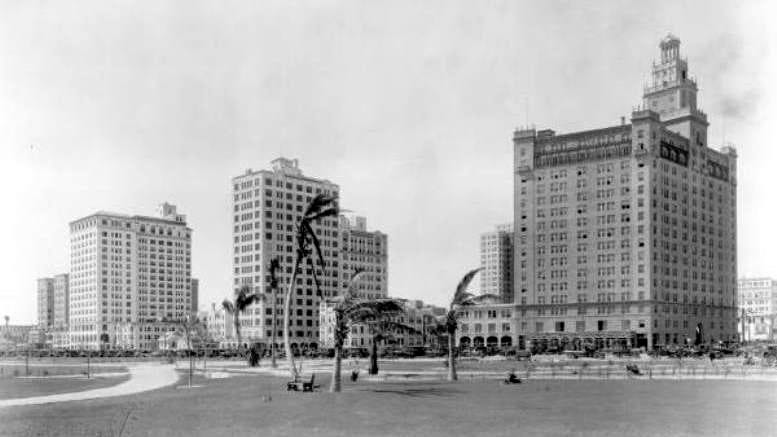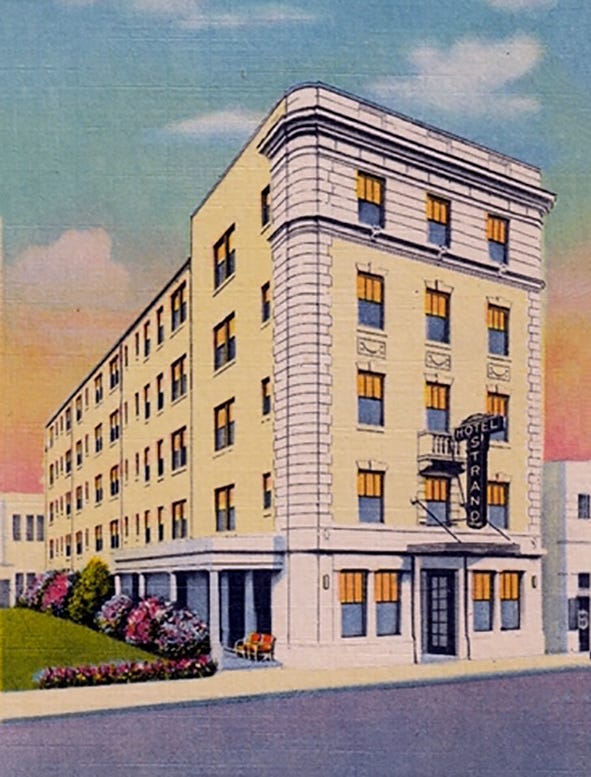Miami Colonial Hotel
Originally the Watson Hotel, and later renamed the Miami Colonial, officially opened on July 1, 1926, at 146 Biscayne Boulevard in downtown Miami.
Only a few of the buildings constructed during the great boom of the 1920s remain as part of today’s skyline. In addition to a court house, several office buildings and a theater, the boom provided three iconic hotels along Biscayne Boulevard which comprised Miami’s first skyline. The Columbus, Everglades and Watson were all built during this era. Having been constructed in 1917, the McAllister Hotel preceded the boom by a few years.
However, only the Watson Hotel remains standing to this day. While it has had a long history of financial troubles, a few controversies, and a lot of name changes, the hotel has demonstrated resiliency from its inception. While most long time residents remember the building as the Miami Colonial Hotel, YVE is the latest brand operating there today. This is the story of the people and events that have shaped more than ninety years of history along Biscayne Boulevard.
Callie Watson & Strand Hotel
By the early 1920s, the city of Miami was growing well beyond its accommodations. It was common for hotel operators from other parts of the country to see this problem as an opportunity. When a widow from upstate New York saw an ad to purchase the lease of a hotel in Miami, she decided to take a chance on a young city far from her home.
Callie H. Watson and her son were running the Watson Hotel in upstate New York when they assumed the final three years of the lease for the Strand Hotel in 1922. The Strand was located at 226 N.E. Second Street, which is now the location of a Metro Mover Station in downtown Miami.
The Strand Hotel was built in 1919 by George A. Persch of Philadelphia. It was five stories in height and contained 68 rooms. The Watsons purchased the remaining term of the lease from John S. Giannone, who placed it on the market because of health issues.
Watsons Purchase Lot to Build New Hotel
Callie and her son operated both their namesake hotel in Niagra Falls and the Strand Hotel in Miami while searching for property to build a much grander hotel. As the 1920s progressed, so did construction activity. Miami was experiencing a great real estate boom by the mid-1920s.
The boom hit its peak beginning in 1925. In February of that year, the Watsons found a corner lot that was perfect for their next project. The lot was located a block and a half east of the Strand Hotel, on the corner of North Bayshore Drive and N.E. Second Street. In the summer of the next year, North Bayshore Drive was renamed to Biscayne Boulevard.
In a Miami News article entitled “Early Days in City Recalled”, published in 1931, Bobo Dean wrote that the lot purchased by the Watsons for their hotel was once an empty lot used as a playground by children of early pioneers who lived along the bay at the beginning of the twentieth century. There was a dock that jetted out from the property before fill extended the shore line east to accommodate Biscayne Boulevard and Bayfront Park.
The Watsons got approval to erect a fifteen-story hotel with accommodations for up to two hundred rooms. The estimated cost for the project was $1 million. Following the approval of the plans by the Miami City Commission, construction began in the summer of 1925.
Construction and Opening of the Watson Hotel
The architectural plans were drafted by George E.T. Wells and G. Lloyd Preacher of Atlanta, Georgia. The project was financed by Northern Capital and the general contractor was Realty Construction Company.
By July, the construction of the foundation was underway. The contractor described laying out the foundation as one of the more difficult tasks of the project. The immense pilings had to be driven deep into poured concrete and spaced close together to ensure the long-term stability of the building.
On the first floor of the building was the lobby, kitchen, dining room and shops along with an arcade. Furnishings and decorations were in keeping with Spanish architecture. The mezzanine floor provided lounges, writing facilities and smoking rooms. A promenade overlooking North Bay Shore Drive extended along the eastern end of the building. There were provisions made for a roof garden to be added at later date.
The lobby had a beamed ceiling and was decorated in tile. The designs of the ceiling and other parts of the public spaces were taken from those found in an armorial room in a famous villa in Barcelona, Spain.
Floors on the lower level were finished with tile, while upper story floors consisted of terrazzo. The building was framed with steel and consisted of an artificial stone exterior to provide a Spanish appearance. The project was originally scheduled to be completed by December 15, 1925.
Although the Watsons had planned on opening their hotel prior to the end of the year, construction delays extended their informal opening to June 26, 1926. A shortage of both materials and labor were responsible for the delay in opening. The Watson Hotel began accepting guests after the informal opening, but didn’t have its grand opening until July 1st. However, the dining room didn’t officially open until October 1st.
Winds of Change and Bankruptcy
The building boom of the mid-1920s changed Miami’s skyline dramatically. Nowhere was that more evident than along the bay front in downtown Miami. As part of the project to create Bay Front Park out of bay bottom fill, the city also decided to expand North Bay Shore Drive and rename it Biscayne Boulevard in August of 1926.
While the expansion of the boulevard was largely considered a positive change, it also created chaos. While it was being expanded, stretches of the road were closed to street and sidewalk traffic. It suddenly became very difficult to access shops and hotels. While the boulevard project was a nuisance, the great hurricane of 1926 was a game changer.
On September 18, 1926 the Great Miami Hurricane swept over Miami and caused tremendous damage and loss of life. It was a once in a generation storm that brought everything to a standstill in Southeast Florida. It is largely considered the last event that led to the bust of the building boom. Everyone was impacted by the storm.
Considering that the Watsons relied on construction loans and other debt to finance the building of the hotel, the storm and its aftermath represented the end of the Watson’s involvement with their hotel. On February 1, 1927, the Watson Hotel was in bankruptcy. George W. Moore was named receiver.
By October of 1928, Moore named James J. Helm as the new manager. Helm ran both the Pancoast and Fleetwood Hotels on Miami Beach before being named manager of the Watson Hotel.
On September 2, 1929, the Watson Hotel was sold to the newly formed Miami Watson Corporation. This company was established by George E. Roosevelt of Roosevelt & Sons from New York, and Edward E. Fleming of the law firm Burdine, Terry & Fleming. The group purchased the Watson Hotel for $350,000.
Edward Fleming became president of the corporation and oversaw operations until they could find a buyer. The purchase of the hotel was largely considered a short-term investment. A little more than six months later, they found a buyer.







